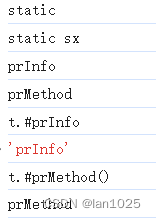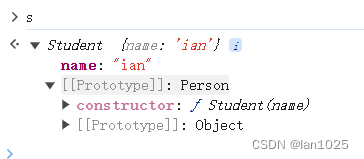class基本核心语法:
//定义类
class Person{
//公有属性(推荐此处定义)
name
// 定义属性并设置默认值
price = 100
//构造函数
constructor(name,age){
// 构造函数内部的this实例化对象
this.name = name
this.age = age
// 动态添加属性(不推荐,查找麻烦)
this.rank = 'QSHQDG'
}
//定义方法(公有)
sayHello(){
console.log('hello')
}
}
// 类实例化
const p = new Person('ian',18)
class实现继承:
//定义类
class Person{
//公有属性(推荐此处定义)
name
// 定义属性并设置默认值
price = 100
//构造函数
constructor(name,age){
// 构造函数内部的this实例化对象
this.name = name
this.age = age
}
//定义方法(公有)
sayHello(){
console.log('papa said hello')
}
}
// 子类继承
class Student extends Person {
age
constructor(name,age){
super(name)
this.age = age
}
sayHi(){
console.log('son said hi')
}
// 就近原则,也可以实现构造函数的重写(多态)
// sayHello......
}
const s = new Student('ian',18)
class静态属性和私有属性
静态属性:定义:使用static关键字;使用:直接用类来调用
私有属性:定义:#开头;使用:带上#且只能在声明该静态属性内部使用
注意:外部不可以直接调用私有属性,但可以通过类中的方法调用私有属性或私有方法,在外部实例化该类后调用方法,间接使用私有属性(浏览器调试工具可以直接调用)
class Test {
// 静态属性和方法
static stInfo = 'static sx'
static stMethod(){
console.log('static')
}
//私有属性和方法
#prInfo = 'prInfo'
#prMethod(){
console.log('prMethod')
}
testPr(){
console.log(this.#prInfo)
this.#prMethod()
}
}
Test.stMethod()
console.log(Test.stInfo)
const t = new Test()
t.testPr()
ES5寄生组合继承:
解释为什么叫寄生组合:
1、组合式继承用到构造函数和原型链
2、在父类原型中有子类构造函数
// 父类
function Person(name){
this.name = name
}
Person.prototype.sayHello = function(){
console.log('papa said hello')
}
// 组合式寄生
function Student(name){
Person.call(this,name)
}
// 通过原型链继承方法
const proto = Object.create(Person.prototype,{
constructor: {
value: Student,
}
})
//创造的原型,赋值给子类的原型
Student.prototype = proto
const s = new Student('ian') 
何为Object.create()?是一种静态方法,第一个参数是源对象,第二个参数是覆盖对象中的特定属性和方法。










